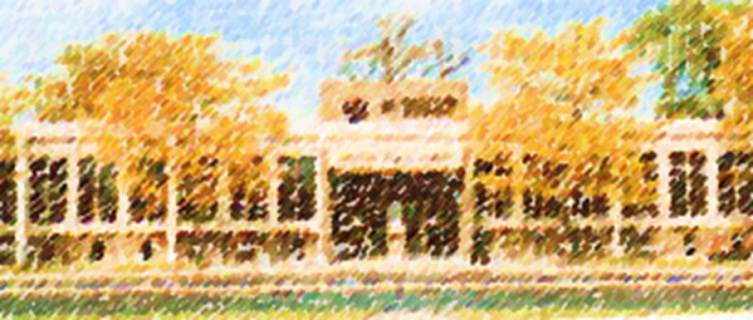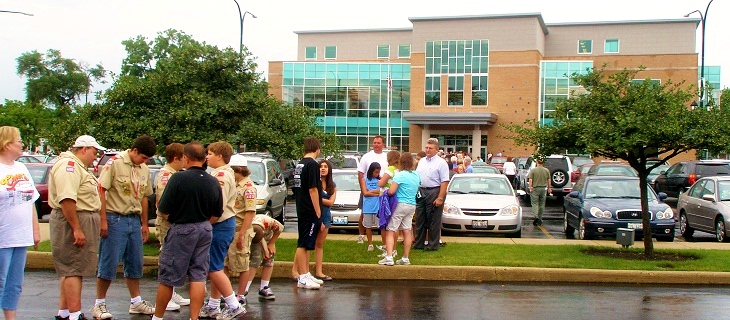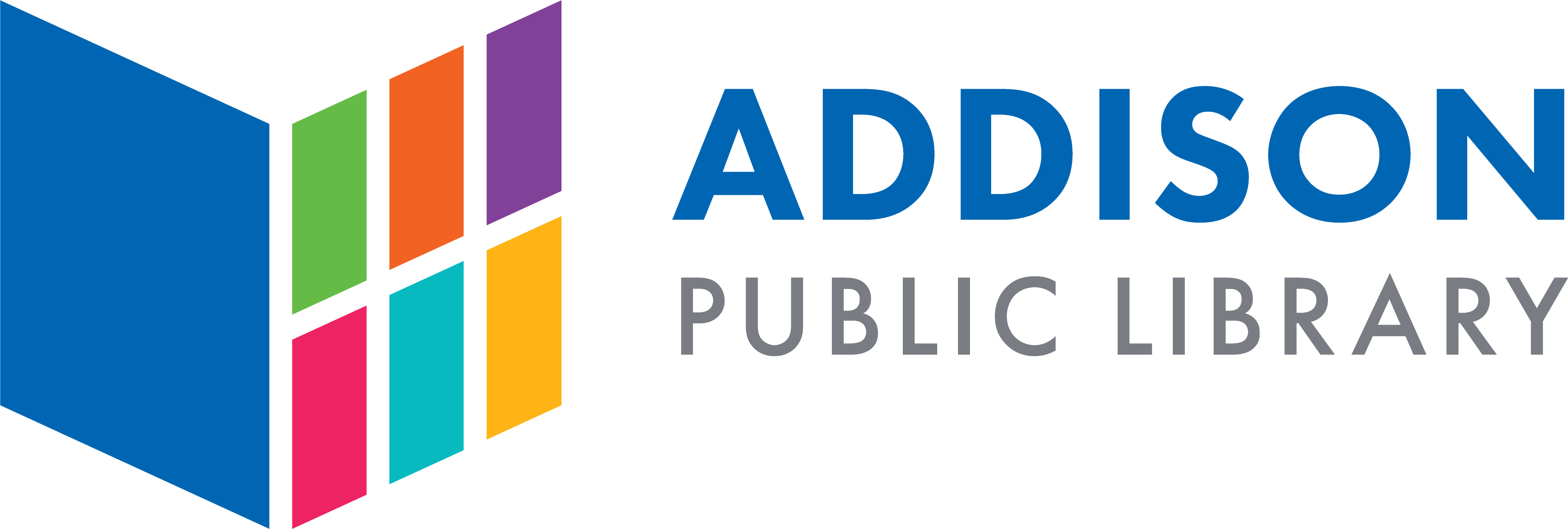
The Beginning
In 1958, The Kiwanis Club of Addison began studying the possibility of establishing a library in the Village of Addison. The Kiwanis Club announced in 1959 that its members had assumed sponsorship of the program for establishing a library and began raising funds. In December, 1960, six members of the Kiwanis Club went to the State Library in Springfield to inquire how to establish a community library.
Two years later, the Addison Village Board granted permission for the remodeling of two rooms in the Municipal Building to house the library. Most of this work was done by volunteers.
The Village Board approved a referendum request to establish a tax-supported library. It asked, "Shall a free public library be established and maintained in the Village of Addison, Illinois?" The voters of Addison passed the referendum with a vote of 437 to 69.
The first board of trustees—Robert H. Schlesselman, William J. Mangold, Nathan B. Winter, Mary Warthen, Raymond G. Dickow, and Mary Jewell—announced the new library would open in the fall of 1962. They needed help to reach that goal. Twelve housewives volunteered, and Trustee Mary Jewell supervised the work of cataloging books, typing catalog cards, and shelving materials. On Monday, October 15, 1962, the Addison Public Library officially opened.

The Library Moves Out
During the 1960s the population of Addison more than tripled, from 7,000 in 1960 to nearly 18,000 in 1966. By this point, the library had grown from two to four rooms in the Municipal Building. Further expansion was needed to meet the increasing demands of the community, but no more room was available. The library needed a building of its own!
Plans for a new building were drawn up and submitted via referendum to the people of Addison. The construction project would cost Addison $400,000. This, voters decided, was too much; the referendum was defeated.
Unwilling to give up, the Board applied for and received a grant from the Illinois State Library Committee. The plans for the new building were modified and the cost of the project was lowered significantly. Supporters of a new library worked diligently, and in March of 1967, their new referendum passed by 22 votes.
Construction of the new building began in August, 1967. The doors to 2 Friendship Plaza opened to the public on October 14, 1968, one day short of the library's sixth anniversary date.
In 1993, the library again was experiencing growing pains. An atrium was added to the front of the building. But even within the library, big changes were taking place as well. The first OPACs—online public access catalog—were installed and a computer lab was soon open. In 1994, the library got rid of its old card catalog, and in 1996, it got a website. Addison Public Library was and remains at the forefront of adopting new technologies to better serve the community.

The New, Green Building
The library's addition wasn't enough—after 15 more years of growth, the library was again bursting at the seams. The village supported this growth and provided $13,000,000 in funding to build the 54,600 square foot building. In the summer of 2008, the ambitious new project was completed and the library opened to the public. Mayor Larry Hartwig and Board President Rob Kepka cut the ribbon on September 21.
The old building is now inhabited by District 88 administrative offices and sits across the parking lot from its new neighbor, 4 Friendship Plaza.
The library's new home is everything its staff and patrons could have hoped for. Spacious, modern, and inviting, the building was also designed to be ecologically sound. Because of these efforts, the library was awarded the prestigious Earth Flag by SCARCE, an environmental group that works to educate the public and build sustainable communities. SCARCE helped the library make many of the environmentally-friendly choices that distinguish us as a modern, green facility.

Library Directors
Ruth Snyder, who came from the Glen Ellyn Public Library, became the library's first paid employee on June 1, 1963. Snyder trained the volunteers, who had little or no library experience. In July, she initiated the first story hour for children. By the end of 1964, the staff had increased to six. At the end of December, 1976, Ruth Synder retired. Under her guidance the library had grown from 2000 borrowed books in two borrowed rooms to a two-level building with more than 50,000 items.
Patricia Kelly became the new administrative librarian in 1977. During the 1960s Kelly worked for the Illinois State Library Fox Valley Project. She was the librarian on the bookmobile that served Addison in 1961. Sixteen years later, she returned to the Addison Public Library.
Kelly hired professional librarians to manage newly created departments. She promoted the use of computers to streamline labor intensive jobs. Technical Services Librarian Harvey Hahn wrote a program that produced catalog cards. More than 150 libraries in the United States, Canada, and Europe purchased "Avant CARDS" from the Addison Public Library.
Kelly left the library in May 1981. Chadwick Raymond succeeded Kelly as the library's administrative librarian.
In 1982 the library began using an automated circulation system, using a database shared by the 15 DuPage Library System libraries and housed at system headquarters in Geneva. Circulation staff used a computer to check materials in and out, and patrons could now access collections in other libraries. Beginning in 1983, computers were available for public use.
Chad Raymond left the library in 1985. Harold C. Ogg replaced him. In 1986 Ogg applied for and received a state grant to establish a Spanish language collection, which has now been expanded to include Albanian, Italian, and Polish language materials. Ogg resigned in 1987.
The Library Board, facing a financial crisis, asked voters for a property tax rate increase on the March 15, 1988, ballet. The referendum failed.
By the time Sharon Hoffman became the director in 1988, she and the Library Board had many difficult financial decisions to make. To help the dollars stretch further, library service was cut 12 hours per week, hours of part-time staff were cut, book and materials budgets were cut 25%, and the number of library programs was reduced. The Library Board decided to again ask voters for a property tax rate increase. The referendum was scheduled for the April 4, 1989 election. This time it passed. The library reopened on Fridays, and sufficient funds would soon be available to resume a wide range of library services. Sharon Hoffman retired on February 2, 2001.
Sharon Campbell, Sharon Hoffman's successor, became the director on April 1, 2001. During Sharon Campbell's tenure the library underwent a number of changes. Most recently completed was the reallocation of space within the library to make room for additional shelving, programming areas, and computer workstations. While Sharon served as director, the Addison Public Library was awarded over $250,000 of grant funding. Most recently, the award winning "Restroom Reading Grant" saw placement of eye-catching posters promoting the use of the library on restroom doors all over town. The campaign has been so successful that the Illinois State Library, which funded this creative grant, has allowed several other states to use these posters in their own "restroom reading" campaigns. Sharon retired on April 30, 2004.
Mary Medjo Me Zengue began her role as director on May 1, 2004. Mary joined the Addison staff in 1996 as the assistant head of Adult Services. After two years she was promoted to the head of Adult Services; two years later she assumed the additional duties of the assistant director, a position she held for four years. For Mary, the staff’s commitment to service remains her highest priority as she looks forward to the challenges that await her. At the Addison Public Library, the board, administration, and staff continually strive to make this Library the best that it can be. As the needs of the community change, the library works to meet those needs.
